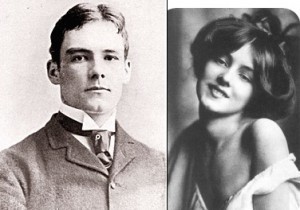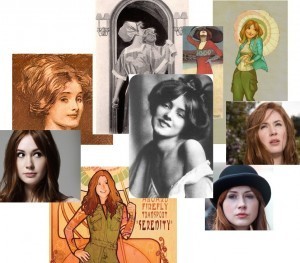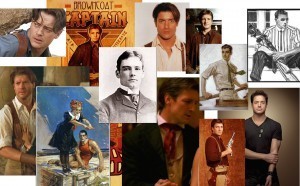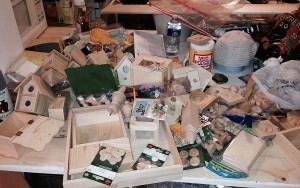Jennifer Crusie's Blog, page 262
October 18, 2014
Questionable: Discovery
Lola asked:
Could you talk about the discovery process? I’m getting back in to an old story and I feel like I need a refresher course in who my character is and the world she lives in. I like her but I think enough time has gone by that who I wanted her to be is different now. I’m older and now I want her to be older and wiser too.
Since I’ve been immersed in the discovery process for the past month, it’s a good time to talk about that. But I will say first that trying to resurrect a moribund book is a lot harder than starting a new one. The old stuff gets in your way. So my advice is to start over with the character you love and see where she goes if you set her free from her old shackles. She’ll probably connect up with the old story in some ways, but starting from scratch can invigorate your brain so that even the old story parts feel new again. And then a lot of the old stuff you just trash. You’re not the writer you were then, and sometimes the old stuff just doesn’t work any more. It’s not a tragedy, it’s just evolution.
So discovery.
First, you need a starting point. Usually for me, that’s my Girl, my central character. She might be sixty, but she’s still My Girl, she’s the one I’m going to invest in and stick with and dream about and think about obsessively. But sometimes, it doesn’t work that way. Sometimes I start with a genre (“I want to write a ghost story, I want to write a Golden Age mystery, I want to write a fairy tale”). Sometimes with a premise. It just depends on how the idea hits. The collaboration we’ve just started began with a format idea from Lani: Four of us would collaborate on a series of stories that would act as episodes in a series, and we’d publish them one a week for sixteen weeks until the entire story was told. And we’d set it in the alternate fantasy/fairy tale world we’d started so long ago. So at that point, we all had to pick our characters.
That’s harder for me, so I looked at the world (I’d been doing a lot of world building) and said, “My Girl lives in the Edge,” which is the slum of the major city in the world. I like the Edge, I’m setting the Zo stories there, that felt right. Lani said, “My girl is a gypsy.” Krissie said, “My girl is disguised as a stable boy.” Toni said, “My girl has magical powers that are consuming her.”
So I defined my girl by her setting, Lani went for community and heritage, Krissie went for complicated character, and Toni went for danger and conflict. They’re all good, we just picked different starting points.
So discovery begins when you find your starting point (obviously) and then it continues as you keep an open mind and build on what you have. For example, location means a lot of things to me and they all feed into who My Girl is, including where she lives and works and who she talks to, the people in the background. So–and for the life of me I can’t remember why–I decided she lived in the bell tower of a ruined church, a place that had toxic magic underneath it but was perfectly healthy at the upper levels. And I decided she was a cat burglar (I don’t know whether that came first or the tower climbing came first) and a pickpocket, who worked as a waitress at the local bar/restaurant. And the extrapolating from that, I know she likes to be alone, she likes heights because she can see so far, she likes the security of the tower (not a lot of people can climb a church tower), she wants a place that all her own, no sharing . . . . That belltower location was my first big clue as to who Cat was.
The second clue came when Toni said that her girl was going to have hellaciously powerful magic, so I said, “My girl has no magic. Isn’t interested in it, would rather not deal with it.” That gave us a nice balance, and Lani and Krissie could fill in somewhere in the middle. Of course, that meant that so far, Cat was a series of negatives–wants to be alone, doesn’t want magic–but I still had the start of her personality.
And that’s really discovery, starting and building on that start and extrapolating out from that, and adding things that seem right–the sticky phase of writing when everything you notice sticks to your story in some way–and then thinking about how that addition shifts the shape of your story. That’s why it’s important to stay fluid and not edit yourself during early discovery: there’s so much about the process that’s intangible. Why does this picture look like My Girl, and this picture of the same real person doesn’t look anything like her at all? Why does this picture of a cottage look like where the antagonist lives, and this picture of a cottage just look like a cottage? The big thing is not to try to explain the why to anybody including yourself. It just does. You’ve discovered it by letting your mind wander, and that’s why your subconscious has latched onto. Never second guess your subconscious. It’ll get mad and leave.
So, for me, everything after discovering who My Girl is at a fairly superficial level is about building her world through locations, people, things, events, anything that floats to mind, while daydreaming about her, listening to her talk in my head. And that means I have to do things that make things float to mind. The things that fuel the daydreams for me, are collage, music, pictures, and (for a collaboration) talking with my collaborators.
Collage: I’ve shown you the collage for this project; the only thing I’d point out in addition now is that I started with the setting as a backdrop so I could fill in the blanks as I went along. I knew the big setting for my story would be Monday Street, so that’s what I built, the setting that Cat grew up in and that defines her to a large degree. Location doesn’t always work as a starting point for collage–sometimes mine are divided into events or turning points or character spheres, or whatever is best for that story–but what I’ve found is that the way I start the collage often tells me what’s important about the story. The Liz collages were filled with people and relationships, family trees, couples, events that were about relationships (eating in the local hang-out, a wedding, etc.). The Bet Me collage was divided into spheres–public outdoors, public indoors, private indoors–because Min shifted who she was and how she felt depending on those places, and her relationship with Cal shifted as he moved up through those spheres. So the key to collage is not thinking about what you’re doing in making the collage, it’s thinking about the story as the collage happens. I’m in the putting-stuff-on-and-ripping-stuff-off stage of the Monday Street collage now, and it’s amazing how much I learn about Cat’s world and what Cat wants as I build it. I can’t emphasize enough: it doesn’t matter what the collage looks like, what matters is what happens in your head as you put it together. The collage is a tool, not a product. That’s why Pam has all of my old ones. Once the book is finished, there’s no point in keeping the collage, any more than there’s any point in keeping the pages and pages of notes I make as I write a book. It’s done. It’s over. Moving on . . .
Music: I also find music can be a big key. Finding the protagonist’s theme, the love interest’s theme, the antagonist’s theme, the love theme, the story theme . . . any of those can open things up. Cat was kind of a stolid lump before I found “God Help the Girl,” and I found it by accident watching Agents of SHIELD. I didn’t even find it while I watching the show, I was just so entranced by that cold open of this cheery, sunny girl going into terrible danger to this happy tune with lyrics that said, “God help the girl, she needs all the help she can get,” that I looked for it later on iTunes and You Tube, and THEN when I played it, I thought, “Oh, WAIT, THAT’S CAT,” and there she was, a generally happy person living in the middle of danger all the time and dealing with it pragmatically but not dully. It was the key piece I needed to get her off the ground.
Pictures: I’m not a visual person, so one thing I do when I’m trying to make something in my head more concrete is find pictures that evoke the things in the story. Most of this stuff doesn’t go in the collage–there’s no room for Cat’s underwear there, for example–but if I know the clothes they wore in 1910, what Cat’s got on under her waitress uniform, what a criminal gang looked like in 1910, then the world starts to build in my head, all the texture and color and detail I need to dream my story. Not write my story, this part is just for me, making the world I daydream about more concrete. Pinterest gives me a place to stash the stuff I find, and then fine tune it as I write the book. It’s not a collage because the point of a collage is the relationships and connections you make between the things you glue down together, and Pinterest is just a bunch of pictures. It’s more visual research notes. It’s also a great place to stash your own pictures if you’ve got a setting you can visit in real life; Bob made me “walk the terrain” for Agnes and the Hitman, and after I got done complaining about it and went with him, it was amazing what I learned. If you’re doing fantasy or you’re too far away from your setting, use Pinterest to walk the terrain. (Warning: Whatever you do, don’t google “vintage sex.”)
Mindlessness: But the biggest part of discovery is daydreaming, paying attention to the stuff drifting through your head about the story. We feel sometimes that unless we’re actually typing, we’re not writing. But the prewriting/discovery part is so vital to the success of your story that I think it might be more important than writing. I know when I’ve tried to write without it, I’ve produced flat dreck. Keep daydreaming your story without any kind of editing, remembering that anything goes because it’s all in your head, and you’ll find that as you repeatedly day dream some scenes, they become not only real and detailed but key to your story.
The last thing to remember about discovery is that it doesn’t stop until you’ve sent your galleys off. As long as you’re writing, rewriting, editing that story, new things will happen, so you keep going back to your notes, your music, your pictures, you keep all of that spinning in your head as your story becomes clearer and clearer in the rewrite. Discovery isn’t what you do before you write, it’s a part of writing, right to the end.

Cherry Saturday 10 18 2014
It’s National Chocolate Cupcake Day in America. Even if you’re not American, please honor our customs today.

October 13, 2014
The Monday Street Collage: More Progress
Since I posted the beginning of the collage, I thought you might like to see the progress. Actually, I thought, “I need a blog post and I have a picture of the collage,” but seeing the progress is also a factor. Again, this is just visual note-taking to keep me in the book; nothing here is set in stone, it can all change, but the stuff that happens in my brain while I’m doing this is so valuable that I don’t care how much stuff I rip off and move around or how messy it is. Not an artwork, a visual notebook. And here’s where I am now . . .
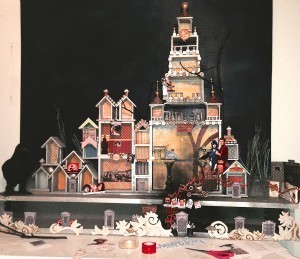
Added paper, pictures, objects, color, and found out a lot more about the story.

October 11, 2014
Cherry Saturday 10-11-2014
Today is It’s My Party Day. Cry if you want to.

October 10, 2014
Questionable: Character Depth
Deb Blake asked:
Character depth has always been an issue for me, although I’m getting better at it (which probably explains why I’ve finally gotten published). How do you make your characters so REAL?
It happens through writing and rewriting. I know there are people who swear by those character sheets where you fill in the blanks, but that never works for me. I couldn’t tell you what color eyes most of my characters have because that has no impact on their stories or on their lives. If I thought about it, I could tell you their worst fears, but a lot of the time that’s not what the story is about. So for me, it’s writing the story and seeing how the character emerges.
If I had to analyze it, I’d say that you need develop a character in two directions–length and depth.
Length is character arc over the length of the story. She’s this character at the beginning, and then THIS happens and she changes as she fights her battles, and that leads to THIS happening and greater changes within her, which leads to THIS happening and so on until the end when she’s a completely different person from who was in the beginning. It’s the arc of those changes, how and why they happen, that creates a rounded character.
But depth is important, too, even though it doesn’t move like plot and character arc. The character’s stable life changes as the plot changes and she changes: her choices in friends, in living arrangements, in what she obsesses over, in what kind of dog she adopts, whatever; think of it as the wallpaper of her life, the patterns that surround her, so that as she moves through the plot, developing her character as the story lengthens, her relationships and choices shift and become clearer and more complex, deepening her character. The wallpaper becomes more detailed, if you will, giving her a richer background and a more rounded character.
I’m always surprised when I read a novel and realize that I have no idea what this character does for a living. Or no idea of where he lives and what that place looks like or what his or her relationships are with people who are not antagonists. A well-rounded character has a life that’s there on the page, not taking up a lot of real estate but present because that’s how life works. Nobody falls in love and then concentrates on that and that only 24/7 until he or she gets engaged. Nobody races to save the world without phoning home. Nobody fights the monster without keeping an eye out for his or her kid. The complications of life shape character, create boundaries and barriers that him or her three-dimensional. And that’s even before you get to how much weight we give to how other people see the character, which can’t be present if there aren’t other people in the cast besides the main combatants.
So how do you know about the character’s life wallpaper? A lot of it shows up while I’m doing early drafts, but I do a lot of discovery, too. Music and collage are big. Why does this song seem to be something she’d play over and over and this song something she wouldn’t even hear? Why do these three pictures of different women look like her to me, and these three other pictures of the same three different women not look like her? I like taking a photo that’s almost right and changing it until it is right–lengthening the face or changing the color of the hair–and I definitely like combining photos and drawings of different people to make a composite in my head. There’s a time while I’m writing that I call Sticky Time, which is when everything I see and hear seems to tell me something about the book and my protagonist: She’d like that dress I saw in a magazine, she’d love that song I just heard on TV, she’d say this to that scrap of conversation I over heard, and so on. Collage is particularly good for that, finding pictures, scrapbook paper, stuff that makes me think, “That’s her.”
But mostly it depends on those two major things: how her character arcs through the events of the plot, and how her world reflects who she is and how she changes. Story event and story world combined to create a dynamic character.
Edited to Add:
So I wrote this yesterday and then left it in draft form so I could give it a couple of hours before I came back to edit it. There are people in my life thwarting me at the moment, and I had to settle their hash (do not give me estimates for an air conditioner I do not want and omit the estimate for the oil tank that must be removed because you are WASTING MY TIME), and I had to clear some of the stuff out of the house, especially the living room which is now collage central and therefore is covered in small bit of paper, and there were a few other things, and the entire time I was just . . . ITCHY. Not externally, but mentally. I’ve been brainstorming this collaborative project with one of our collaborators (the other two are up to their asses in alligators), and we’re making great progress, talking about the world, and I know about my character, Catherine, aka Cat, a waitress/cat burglar in 1910, and since it’s a romance/adventure/fantasy, there’s her future guy, Harry, a gangster/undercover cop, and I know that there’s nothing magic about Cat, that she’s extremely down to earth except when she’s on a rooftop, very pragmatic, very young (another Mare), and that Harry’s not quite so young, rising fast in the force, and . . . I couldn’t get past that. I had pictures but they weren’t right. It made me itchy.
And the thing is, I know I won’t know these people until their story is finished. That’s just how it works. But there is thing that happens, something triggers something in my brain, and suddenly, they come alive and I can hear them talking and I know what they’re thinking, and the other people around them, and that’s the thing I have to get to. And it’s really hard because you don’t know what the trigger’s going to be. Pictures, yes, music, yes, could be anything, so you just have to keep open, sticky time, and pray that you get it.
Agents of SHIELD is really good this year, and the cold open for this week’s was truly brilliant, Jemma dressing to go to work to this peppy retro pop song and then she gets to work and it turns out . . . well, that’s a spoiler, but it was great. And the song was fun. So I bought it. No big deal, I’ll use it some day. Then for the last couple of nights I’ve been looking at pictures of people from 1910, trying to find somebody that looked like Cat, in the sense of personality not actual physical looks. I pulled a lot of stuff for her and for Harry while I was at it, but it just wasn’t right. Then tonight, restless as all hell, I clicked on the song, and bang, there it was. Obviously the lyrics are not right for 1910, but the sense is, and the bounce. There’s a lot of darkness in this story, and that’s what was screwing me up. Cat’s not dark. She doesn’t have enough imagination to be dark. She has no magic powers. She’s not the reincarnation of an Egyptian Queen or the long lost heir to a throne or anything but an ordinary waitress/cat burglar who needs to find a way to heat the church bell tower she’s been squatting in or she’ll freeze to death over the winter. All the dark magic that’s going on around her that the other women will be suiting up for, Cat just wants it out of her crypt because it’s going to blow her secret hideaway. She’s practical. If they had HGTV in 1910, Cat would have been calling them for HVAC advice. There no drama in Cat. But god help her, there’s plenty around her. And then that gave me Harry who lost about ten years in age and became her analog, the young cop who thinks he can do anything. I kept playing the song over and over and pulling pictures off the net to get my composite, different faces with the same personality because what I want isn’t what they look like, I don’t care what they look like, what I need is who they really are, what makes them bounce on the page.
Up above, I said I use music and collage. Cat’s theme is “God Help the Girl” by God Help the Girl (and thank you, SHIELD). Cat and Harry will look like this after they’ve been together for a couple of years:
But the way they are right now is a composite of these personalities/attitudes/worldviews:
Come on, how much fun is that?
Now, please God, let me keep them alive in my head until I can get their stories written.

October 7, 2014
Questionable: What’s Too Much Detail in a Sex Scene?
Gina asked:
How do you know if your sex scene has too much detail? This is a scene that’s necessary for the story to move forward because it reveals character and/or moves plot. I have one in my manuscript, which is a first person narrative, and I had one test reader say it was fine just needed some fine tuning. I had another test reader say, that though the scene is a good scene, it’s not necessary at all and should be cut short.The scene has been revised multiple times before anyone read it – it started short and vague, then got really detailed, then was cut again – so how do you know if the details are too much? Does point of view make a difference in the amount of detail included?
The first requirement of any scene is that is move the story and show character change, not just “here’s what this character is like,” but “the events of this scene have such an impact that the character is different at the end than she or he was at the beginning.” The changed doesn’t have to be huge, but it has to be clear. So “reveals character” isn’t enough, but good for you for moving plot.
Then your real question: “How much detail?” The first thing I’d ask is, “Who’s your reader?” One thing about betas, God bless them everyone, is that they’re all different. One good thing about getting several betas is that you can spot the outliers, but essentially, you are never going to write a scene (or a book) that everybody likes. It’s never going to happen. So that’s why you always go back to the real question, the Big Question:
What is this book about?
What’s the promise you make in the first scene and fulfill in the climax, where’s the juice in this story, what matters most to the story you’re telling?
Obviously if you’re writing erotica, detail is extremely important because the book is about sex, about creating those feelings for the reader.
If you’re writing a suspense story, detail is probably unnecessary and may even be harmful as it takes up page real estate from the suspense story you promised the reader.
So if you’re writing a romance, you have to ask, “Where is the tension in this love story? How does this sex scene change this story? And what does the detail in this sex scene do for this story? Essentially, what does this sex scene do for this love story, and what do I need to include in order for it to serve this love story best?” Then you write that.
Sex scenes always cause stress in writers, they’re fraught with pitfalls that are made deeper by our own fears and hang-ups. I used to look at my sex scenes and think, “Will people think I’m depraved? Will people think I’m boring? Will people think I’ve never had sex and I’m just guessing?” Now I look at them and think, “This is what the story needs” and cut everything else. Makes it much easier.
What makes them much harder? Writing them in first person. First person establishes a much more intimate relationship with the reader because it feels as though you’re talking directly to him or her about your (fictional) self instead of standing at a distance and talking about someone else. If your character is the kind of person who would discuss her sex life with a stranger on the bus, you’re home free. But if your character is somebody who’s private, somebody who probably wouldn’t discuss intimate details with people other that his or her lover, then you have to figure out how to get around that barrier. So in first person, I think it comes down to the personality and voice of your first person narrator. How much detail would she or he share and still be in character? Then go back to the Big Question, and revise according to that.

October 6, 2014
The Birth of a Collage
So Saturday night, I’ve been thinking about the story, and I feel the need to collage. I need to see the church and the tavern and the street, I need to get the tone and mood of the story down. It’s slippery. I want a fun world but not a farce. I want darkness but not dystopia and dread. I need a visual. So I take a nap and dream about building this collage and when I wake up, I haul all my boxes and bags that should be labeled “Wood Crap” out and start going through them. At 6AM, I have the major part of the collage built, just need the base and the back board and a lot of spray paint. I go to bed, get a solid six house of sleep, get up and make the base (a lousy job, but it’s collage not part of my house, so no worries) and the backing board (I love the way the first coat of spray paint mottles on wood, just like a night sky) and then put it all together, badly because I’m thinking about the story, not about what I’m building. By Sunday at five, I have the base structure of the collage built. After this, it’s paint and paper and found objects stuck on as I tell the story to myself and write it down, an ongoing visual notebook. It’ll take months to finish this and the story, but for right now, I have the start of my collage and the start of my book. Here’s the step by step version. Please ignore the mess that is my house and front walk. Thank you.
Step One: Dump all the wood crap out on the counter. Continue to find more as you work.
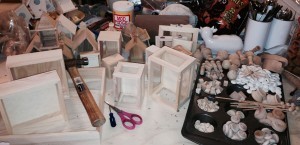
Step Two: Organize wood crap.
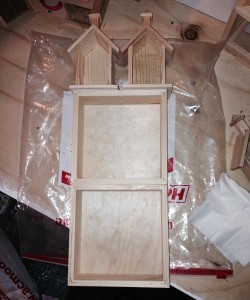
Step Three: Build the easy setting, Maggie’s Tavern, four stories with attic. (Put in floors later, probably with paper.)
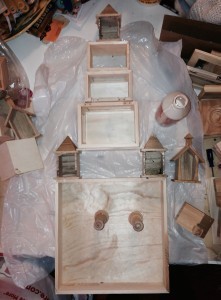
Step 4: Build the basic church. Embellish later.

Step 5: Assemble Monday Street.
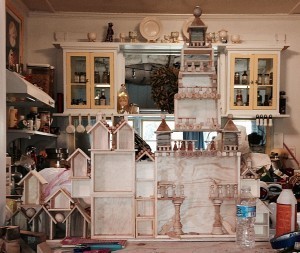
Step 6, Set the street upright and embellish.
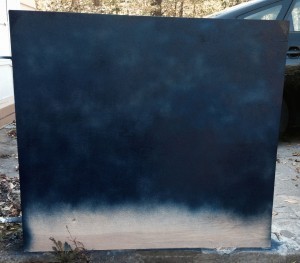
Step 7: Spray paint the backing board.
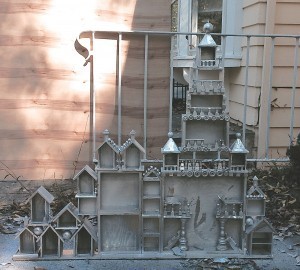
Step Eight: Spray paint the street.

Step 9: Assemble the base. Then spray paint with stone paint.
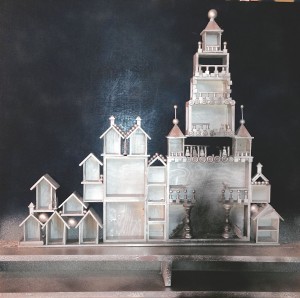
Step 10: Put it all together. (That black blotch is not a lighting problem, it’s where the crypt exploded and took out the bottom stories of the church.) Next steps: paint, paper, pictures, junk stuff, STORY.

October 5, 2014
Back Story: An Example in Progress
We were talking about back story a couple of days ago at the same time I was working out some back story on something I’m writing.
Here’s the back story, as I explained it to somebody else:
Maggie (not her real name), the woman who runs Maggie’s Ear, the tavern/inn on the docks in the Edge where Cat and Krissie’s stable girl work, was an underage prostitute in 1860. She worked in the building she owns now, the Ear, for a madam named Madame Avarice, and the house was called The Inn of the Seven Sins. It was a fairly high class bordello with a lot of role-playing with devils and angels and an S&M room in the basement called Hell. So drinking, gambling, screwing, guys thinking they’re real men, bored girls, etc. Lots of wealthy clients that Madame Avarice catered to.
So Maggie (not her real name) is seventeen, already street smart, looking for money because to her money means security, and Madame Avarice comes to her with an offer. Seven of their wealthiest clients want to have a black mass orgy in the crypt of the nearby church, The Church of the Seven Saints. (It’s been there for a couple of centuries, Madame Avarice chose the name of her house because of it.) Each girl will represent one of the seven deadly sins, and there’s been a special request for Maggie to play Lust, Maggie being a healthy girl with good lungs and staying power. Maggie, seeing how important it is that she say yes, says she will on one condition: Madame Avarice makes a will leaving the House to Maggie. Madame Avarice, knowing that she’ll probably outlive a prostitute (the average age for death for London prostitutes in the mid-century was seventeen), agrees and they go to a lawyer and get it all drawn up, absolutely legal. Maggie even brings her own lawyer, but Madame Avarice for once is on the level. So the orgy is arranged, they all sneak into the crypt—seven men, seven girls, and Madame Avarice—and the place is dressed like a stage play because Madame Avarice knows what she’s doing. Lots of arcane symbols drawn on the wall (she got them out of a book), lots of skulls and daggers and chalices (she hit the flea markets), and seven mattresses on the seven stone coffins of the seven saints. They start the orgy and everybody’s getting into it as Madame Avarice does some mumbo jumbo over the altar she rigged up, and then Things start to happen, and Maggie realizes that Avarice has managed to actually raise something Awful, and she drops behind the nearest coffin, the coffin of St. Margaret the Strong, and as the dust starts to swirl into symbols and the walls of the crypt glow red, she prays to St. Margaret to save her, the first and last prayer of her life, and then everything goes red and black.
When she wakes up, there’s been a magic implosion, the church’s first floor is destroyed, the roof and five of its seven gargoyles gone, windows blown out, and a gaping hole in the floor above the crypt. Maggie’s the only one left alive, and she’s feeling odd. She hears voices, realizes the law is approaching, and after giving St. Margaret’s coffin a pat, she crawls out through the wreckage and makes her way back to the House of Seven Sins where she goes to her room and thinks. And what she mostly thinks is that Madame Avarice is dead and she owns the House. So after a respectable amount of time (fifteen minutes), she washes up, puts on a dress that shows no cleavage, ties her hair in a demure bun above her head and goes to see the lawyers. Then she goes back to the house, throws everybody out, finds where Madame Avarice kept her money—lots of it—takes down the flocked the wallpaper and all the Seven Sin’s stuff, and reinvents herself as Margaret Strong, later Maggie, the proprietor of a respectable tavern and inn. The place is in the Edge, so “respectable” is a matter of degree, but it gradually establishes itself as a place where both criminals and coppers can drink without hassling each other because Maggie does not put up with That Sort of Thing. Also, anybody who touches a waitress is thrown out and barred for life. This works because there’s something odd about Maggie and her dark eyes and her cheeks that get more sunken every year, and her voice like a lead dagger. Also, the fact that she’s in her sixties and in most lights doesn’t look a day over thirty has some people wondering, not that they’d ask. They don’t want to know that badly. Something happened to Maggie in that crypt the night, and not even she knows what it is, but she never takes off her St. Margaret’s medal, and she makes sure that all her waitresses light a candle under the portrait of St Margaret before they go home for the night. Something the girls have noticed but are not saying: With every year, Maggie looks more and more like St. Margaret.
So how much of that is going into the story I’m writing? None of it.
The story is about Cat, a twenty-something waitress/pickpocket/cat burglar who works for Maggie but is living in the belltower of the old church. The things the reader needs to know to understand Cat’s story:
The belltower is the top three stories of the church, and Cat is living there illegally because the church is condemned, which is clear from the Condemned sign she climbs over to get into the place.
There’s magic fall-out in the crypt, which she can see sparking when she looks over the edge of the belltower through the broken roof below.
Maggie, her boss, is odd but is fiercely protective of the women who work for her as waitresses, something that’s made clear in the first scene.
In other words, I can show everything the reader needs to know without ever mentioning that back story. Cat’s goal is to keep her home safe and make it warm for winter without getting caught. That leads her to take on the crooks that are using the crypt for something nefarious. All of that is in the now.
Is the back story fun? Yes, I had a blast writing that in about fifteen minutes one night.
Is the back story interesting? A plucky heroine, sex, magic, wills, explosions, sure it’s interesting.
Is the back story necessary to tell the story I want to tell, Cat’s story? Nope.
So none of it goes in. At no point does anybody stop to tell the story of the Night the Crypt Exploded. First, it was forty years ago and the only person who really knows what happened is Maggie and she has no reason to tell it to anybody. Second, it was forty years ago and therefore has no impact on the story in the now.
When the project is done, if it ever is, and we set up a website, if we ever do, we can add a history section and put in a page about the Black Mass Avarice Orgy, but it’s never going into a story. I don’t even think I could write THAT story because Maggie isn’t really fighting an antagonist, she’s just making a plan and then something goes wrong that has nothing to do with her and she hides and survives. It’s an incident, not a plot.
Put the back story on the website as an extra. Write the story in the now.

October 4, 2014
Cherry Saturday 10 – 4- 2014
Today is International Frugal Fun Day. Cheap out on the good times, it’s a worldwide necessity.

October 2, 2014
Questionable: Back Story
el7 asked:
Say you have a character who had a life defining moment in their past that of course bears on their present because, life defining. How do you handle relaying that to the reader? There always comes a moment when they need to explain it to someone. Is the conversation enough to bring that across or should you go for the flashback? I always feel odd about it because it can break POV to do a flashback, plus I remember that conversation in Jaws where Quint relates a story about surviving a shipwreck during WWII and that was very powerful without resorting to a flashback. But then you have to go to monologue and that’s tricky in its own right. What’s the best way to approach that kind of moment in a narrative?
I had a life-defining moment on May 4 in 1970. I was nineteen years old, a good girl, a child of strict Republican parents who taught me to always obey authority and that the government was there to protect me. I was in school at Bowling Green State University, which is in northwestern Ohio, and on May 4, the National Guard shot and killed students like me at Kent State, another Ohio state school that was so close to us that when they closed Kent, the students came to our campus. The problem with a strict, absolute belief is that it can’t rebound from a blow, it cracks and shatters and there’s nothing left. I went from a 3.8 grade point to a .9, went from being a law-abiding citizen to a peace protestor, went from being my mother’s good girl to being a pot-smoking hippie who gave up her virginity without a qualm and never met an authority that didn’t make her say, “Hell, no.” That was a life-defining moment. Today the only time I think about it is when somebody says, “Kent State,” and for that moment the rage and the fear and the betrayal comes back, but only for that moment. Then I go on with my life because my world changed that day, but it was forty-four years ago. It changed me then, it doesn’t change me now.
And that’s the problem with back story. It’s in the back of the story, not at the front where the action and character arc and the change is. Using back story for motivation in the now isn’t just lazy, it’s useless. “He shot up his workplace because he had a bad childhood.” Yeah? Everybody I know had a bad childhood and none of us have shot up a Walmart. He didn’t do it because of his bad childhood, he did it because of something now. If it was because of his bad childhood, he’d have done it as a child.
Okay, that’s facile, but the thing about fiction is that it’s supposed to be better than reality. We go to fiction because the real world is chaotic and often meaningless, and good fiction gives us a rational world, and “This happened ten years ago which is why I’m doing this today” isn’t rational. Rational is, “This happened ten years ago and I changed and got on with my life and then THIS HAPPENED TODAY and now I’m doing this, in part because of my memories but really because of THIS THING THAT HAPPENED TODAY.” It’s not that our pasts don’t do a lot to shape who we are today, it’s that they don’t do anything to CHANGE who we are today, and change is what story is about, the day that is different. Your character isn’t what happened to her in the past, it’s who she is now on the page, how she talks, acts, treats people, handles problems now. If you want a shorter reason not to do back story, back story is telling, story in the now is showing. If your character wastes her story real estate in the now to moan about the past, she’s not doing anything.
So ask yourself, “Is that moment in the past really the defining moment in my character’s life?” Because if it is, that’s the story you should be writing. And if the story you’re writing now is another defining moment in the character’s life (most of us have multiple defining moments), then write about that one, not about the other story. Once again, pick a lane, but keep that lane, whatever it is, in its own now so you’re not hobbling your protagonist. There’s a reason Miss Havisham is not the lead character in Great Expectations: trailing around a mansion in a wedding dress from your aborted nuptials from thirty years before makes you an object of pity and revulsion, not a heroine. Think of your back story as a rotting wedding dress and let it go.
And now forty people will tell me I’m wrong and give me examples of great flashbacks. You know what? A flashback might be fascinating, it might be riveting (Quint is a good example), it might be amazing, but it’s never going to move story. So, no.



